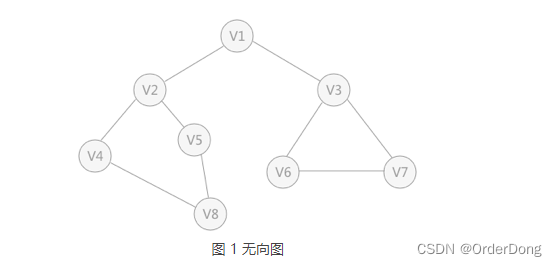无向图

使用邻接矩阵顺序存储此无向图
先构造存储,在遍历
深度优先遍历
深度优先遍历(Depth_First_Search),也有称为深度优先搜索,简称为DFS
深度优先搜索的过程类似于树的先序遍历,首先从例子中体会深度优先搜索。
根据上边的过程,可以得到图 1 通过深度优先搜索获得的顶点的遍历次序为:
V1 -> V2 -> V4 -> V8 -> V5 -> V3 -> V6 -> V7
所谓深度优先搜索,是从图中的一个顶点出发,每次遍历当前访问顶点的临界点,一直到访问的顶点没有未被访问过的临界点为止。然后采用依次回退的方式,查看来的路上每一个顶点是否有其它未被访问的临界点。访问完成后,判断图中的顶点是否已经全部遍历完成,如果没有,以未访问的顶点为起始点,重复上述过程。
深度优先搜索是一个不断回溯的过程。
广度优先搜索
广度优先搜索类似于树的层次遍历。从图中的某一顶点出发,遍历每一个顶点时,依次遍历其所有的邻接点,然后再从这些邻接点出发,同样依次访问它们的邻接点。按照此过程,直到图中所有被访问过的顶点的邻接点都被访问到。
最后还需要做的操作就是查看图中是否存在尚未被访问的顶点,若有,则以该顶点为起始点,重复上述遍历的过程。
还拿图 1 中的无向图为例,假设 V1 作为起始点,遍历其所有的邻接点 V2 和 V3 ,以 V2 为起始点,访问邻接点 V4 和 V5 ,以 V3 为起始点,访问邻接点 V6 、 V7 ,以 V4 为起始点访问 V8 ,以 V5 为起始点,由于 V5 所有的起始点已经全部被访问,所有直接略过, V6 和 V7 也是如此。
以 V1 为起始点的遍历过程结束后,判断图中是否还有未被访问的点,由于图 1 中没有了,所以整个图遍历结束。遍历顶点的顺序为:
V1 -> V2 -> v3 -> V4 -> V5 -> V6 -> V7 -> V8
邻接矩阵深度和广度优先遍历
直接上代码
package com.my.data.structure;
import java.util.*;
/**
* 图邻接矩阵深度优先遍历和广度优先遍历
*/
public class GraphTest {
public boolean[] isVisit; //是否被访问过,深度优先
public boolean[] bfsVisit; //是否被访问过,广度优先
public class Graph {
public List<String> vertex; //顶点集合
public int[][] matrix; //邻接矩阵集合
public int edge; //边数
/**
* 构造
*
* @param n 顶点数
*/
public Graph(int n) {
vertex = new ArrayList<String>(n);
matrix = new int[n][n];
isVisit = new boolean[n];
bfsVisit = new boolean[n];
}
/**
* 添加节点
*
* @param v 节点名称
*/
public void addVertex(String v) {
vertex.add(v);
}
/**
* 构建邻接矩阵数组
*
* @param i
* @param j
* @param val
*/
public void addMatrix(int i, int j, int val) {
this.matrix[i][j] = val;
this.matrix[j][i] = val;
}
public int[][] getMatrix() {
return this.matrix;
}
}
/**
* 创建图
*
* @param n
* @return
*/
public Graph createGraph(int n) {
return new Graph(n);
}
/**
* 邻接矩阵顺序存储
*
* @param graph
*/
public void createMatrix(Graph graph) {
/**
* V1 V2 V3 V4 V5 V6 V7 V8
* V1 0 1 1 0 0 0 0 0
* V2 1 0 0 1 1 0 0 0
* V3 1 0 0 0 0 1 1 0
* V4 0 1 0 0 0 0 0 1
* V5 0 1 0 0 0 0 0 1
* V6 0 0 1 0 0 0 1 0
* V7 0 0 1 0 0 1 0 0
* V8 0 0 0 1 1 0 0 0
*/
graph.addMatrix(0, 1, 1);
graph.addMatrix(0, 2, 1);
graph.addMatrix(1, 0, 1);
graph.addMatrix(1, 3, 1);
graph.addMatrix(1, 4, 1);
graph.addMatrix(2, 0, 1);
graph.addMatrix(2, 5, 1);
graph.addMatrix(2, 6, 1);
graph.addMatrix(3, 1, 1);
graph.addMatrix(3, 7, 1);
graph.addMatrix(4, 1, 1);
graph.addMatrix(4, 7, 1);
graph.addMatrix(5, 2, 1);
graph.addMatrix(5, 6, 1);
graph.addMatrix(6, 2, 1);
graph.addMatrix(6, 5, 1);
graph.addMatrix(7, 3, 1);
graph.addMatrix(7, 4, 1);
}
/**
* 邻接矩阵深度优先遍历
*
* @param graph
* @param i
*/
public void dfsSort(Graph graph, int i) {
if (isVisit[i]) return;
isVisit[i] = true;
System.out.print(graph.vertex.get(i) + " ");
int[][] tmp = graph.getMatrix();
for (int j = 0; j < graph.vertex.size(); j++) {
if (tmp[i][j] == 1 && !isVisit[j]) dfsSort(graph, j);
}
}
/**
* 邻接矩阵广度优先遍历
*
* @param graph
*/
public void bfsSort(Graph graph, int i) {
if (bfsVisit[i]) return;
bfsVisit[i] = true;
System.out.print(graph.vertex.get(i) + " ");
Queue<Integer> queue = new LinkedList();
queue.add(i);
while (!queue.isEmpty()) {
int idx = queue.poll();
for (int j = 0; j < graph.vertex.size(); j++) {
if (graph.getMatrix()[idx][j] == 1 && !bfsVisit[j]) {
bfsVisit[j] = true;
System.out.print(graph.vertex.get(j) + " ");
queue.add(j);
}
}
}
}
public static void main(String[] args) {
int n = 8;
String[] vertexs = {"V1", "V2", "V3", "V4", "V5", "V6", "V7", "V8"};
GraphTest graphTest = new GraphTest();
Graph graph = graphTest.createGraph(n);
for (int i = 0; i < vertexs.length; i++) {
graph.addVertex(vertexs[i].toString());
}
graphTest.createMatrix(graph);
/*int[][] data = graph.getMatrix();
//System.out.println(Arrays.deepToString(data));
//测试邻接矩阵二维数据
for (int[] tmp : data) {
for (int x : tmp) {
System.out.print(x + " ");
}
System.out.println();
}
*/
System.out.println("邻接矩阵深度优先遍历");
List<String> vertexList = graph.vertex;
for (int i = 0; i < vertexList.size(); i++) {
graphTest.dfsSort(graph, i);
}
System.out.println("");
System.out.println("邻接矩阵广度优先遍历");
for (int i = 0; i < vertexList.size(); i++) {
graphTest.bfsSort(graph, i);
}
}
}
结果显示
邻接矩阵深度优先遍历
V1 V2 V4 V8 V5 V3 V6 V7
邻接矩阵广度优先遍历
V1 V2 V3 V4 V5 V6 V7 V8
Process finished with exit code 0























 556
556











 被折叠的 条评论
为什么被折叠?
被折叠的 条评论
为什么被折叠?










